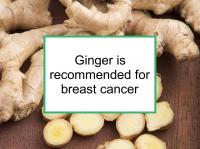Ginger refers to the fresh or dried rhizome (underground stem) of the ginger plant (Zingiber officinale). Ginger contains numerous compounds that have been shown to have antioxidant, anti-inflammatory, antimicrobial, antiviral, antifungal, anti-arthritic, hypotensive, antiatherogenic, radioprotective and antiemetic properties.
Ginger is believed to affect serotonin receptors in the digestive tract and it has been used traditionally to aid digestion and treat stomach upset and nausea. Ginger may assist in prevention of the progression of type 2 diabetes through its hypoglycemic effects and by increasing insulin sensitivity.
Ginger is a very good source of compounds that have been shown to have anti-cancer effects, including various gingerols, shogaols, gingerdiones and diarylheptanoids, as well as zingerone and β-elemene. Ginger is also a dietary source of caffeic acid, citral and paradols. Ginger has been found to have beneficial effects in cell and animal prostate cancer models and to suppress colorectal, skin and lung carcinogenesis in laboratory animals. Ginger has also been shown to inhibit the growth of leukemia cells, as well as gastric, pancreatic, liver and ovarian cancer cells in the laboratory. There is also some evidence that consuming ginger could mitigate the carcinogenic effects of exposure to bisphenol A (BPA).
Breast cancer-related effects of eating ginger
Animal studies
Ginger has been found to significantly inhibit mammary tumorigenesis and tumor growth in laboratory mice when fed in drinking water. Ginger compound 4-shogaol has also been shown to inhibit metastasis in a mouse model of triple negative (ER-/PR-/HER2-) breast cancer.
Ginger compounds and breast cancer
Gingerol and shogaol compounds are found in both fresh and dried ginger. However, since gingerol is converted into shogaol during dehydration, fresh ginger has a higher gingerol fraction than dried ginger and the opposite holds for shogoal.
Ginger compound 6-gingerol (the most important gingerol) has been shown to inhibit cell adhesion, invasion, and motility in triple negative breast cancer cells in the laboratory. 6-gingerol has also been demonstrated to reduce hormone receptor positive (ER+/PR+) cell growth and proliferation. In addition, 6-gingerol has been reported to selectively kill breast cancer stem cells in a population of ER+/PR+ cells.
10-gingerol has been reported to inhibit ER+/PR+, HER2 overexpressing (HER2+) and triple negative breast cancer cell growth and progression, reducing proliferation and invasion. 10-gingerol has also been shown to downregulate the expression of epidermal growth factor receptor (EGFR). EGFR overexpression has been linked to poor breast cancer prognosis.
Ginger compound 4-shogaol has been found to inhibit the migration and invasion of triple negative breast cancer cells. 6-shogaol has been shown to induce ER+/PR+ and triple negative breast cancer cell death and inhibit the formation of breast cancer stem cell-like spheroids.
Ginger diarylheptanoids have been shown to suppress triple negative breast cancer cell proliferation. One 2021 study reported that five ginger diarylheptanoids had greater cytotoxic activity against triple negative cells than curcumin, the most important diarylheptanoid in turmeric.
Ginger and breast cancer treatment
Ginger compounds 6-shogaol and zerumbone have been demonstrated to increase the cytotoxic effects of paclitaxel. 6-gingerol and 10-gingerol have both been been found to increase the effectiveness of doxorubicin chemotherapy. 10-gingeral has also been reported to reduce doxorubicin-induced liver damage in a mouse model of breast cancer. Gingerol, shogaol, and paradol compounds have all been demonstrated to enhance the cytotoxicity with platinum-based drugs such as cisplatin, reducing migration and increasing programmed cell death.
Ginger appears to be safe to consume in moderation during tamoxifen treatment. Tamoxifen is metabolized primarily in the liver by the cytochrome P450 enzymes CYP2D6 and CYP3A4. All three gingerols (6-, 8-, and 10-gingerol) have been found to exert weak inhibition on CYP2D6 and moderate inhibition on CYP3A4. Therefore, gingerol appears to have the potential inhibit the metabolism of tamoxifen to its active metabolite and gingerol supplements should be avoided. However, normal use of ginger in meal preparation is unlikely to interfere with tamoxifen treatment. Please see the webpage on turmeric and tamoxifen for a more complete discussion of tamoxifen metabolism.
Ginger has been found to be effective in treating chemotherapy-induced nausea and vomiting, although not all studies agree. The key appears to be to take the ginger before undergoing a chemotherapy treatment, as well as afterwards.
Additional comments
Tropical ginger and wild ginger
Edible tropical ginger (Zingiber zerumbet Smith), also known as subtropical ginger, contains compounds, such as zerumbone and 1'-acetoxychavicol acetate, which have been shown to have anti-breast cancer effects in the laboratory. However, note that this particular ginger is typically not sold as a food in the U.S. and many "tropical gingers" are inedible ornamental plants.
Wild ginger (Asarum canadense), which is used in some weight loss and Chinese herbal preparations, should be avoided. Wild ginger incorporates aristolochic acid, which has been shown to be toxic to the kidneys and is a suspected human carcinogen.
Ginger ale
Ginger ale or ginger beer is a soft drink that, as formulated commercially, typically contains high amounts of sugar and low or nonexistent amounts of ginger. For example, one major brand of ginger ale contains the following ingredients: carbonated water, high-fructose syrup and/or sugar, citric acid, natural flavors, sodium benzoate and caramel color.
Sources of information provided in this webpage
The information above, which is updated continually as new research becomes available, has been developed based solely on the results of academic studies. Clicking on any of the underlined terms will take you to its tag or webpage, which contain more extensive information.
Below are links to 20 recent studies concerning this food and its components. For a more complete list of studies, please click on ginger.
